Table of contents
- Driving in the wet and in the dark Special conditions
- Bends in the wet: drive soft lines
- Wet roads: danger of slipping
- Tire grip in the rain
- Aquaplaning on a motorcycle
- Riding a motorcycle in the dark
- Frustration can be a source of danger
- Construction site exits
- Restricted areas
- Bridge heels
- Manhole cover
- bitumen
- Road markings
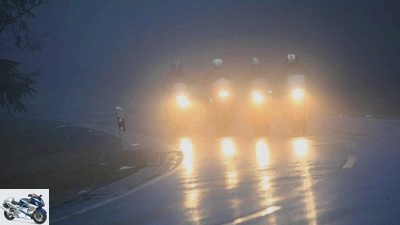
Rosen Gargolov
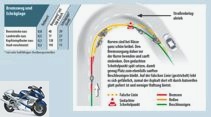
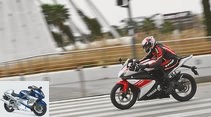
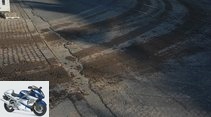
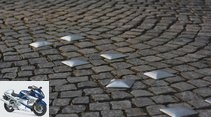
12th pictures
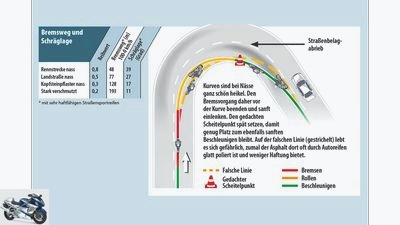
MOTORCYCLE
1/12
The measured values of a Honda CBR 600 F show how different road surfaces in the rain affect the braking distance and the possible lean angle. The braking distance is hardly longer on grippy racetrack asphalt than on dry slopes. On the wet country road, the sports tourer needs 77 meters to brake hard from 100 km / h, and on bad surfaces it is significantly more. In addition, the possible inclination is drastically reduced.

2snap
2/12
In the dry, zebra crossings and other road markings are no problem, but when it rains the applied plastic is as smooth as a mirror. Therefore do not accelerate or brake, but simply let the motorcycle roll over them.
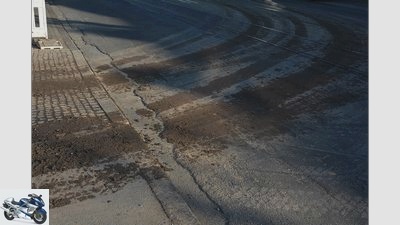
Streblow
3/12
These traces of a construction site exit easily throw the motorcycle out of step. In addition, construction workers or construction vehicles can suddenly appear and suddenly force you to brake, which is no fun on such a surface.
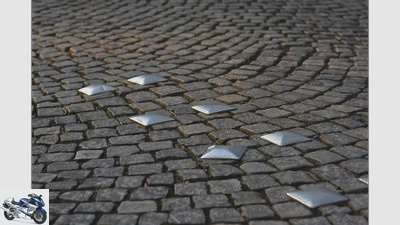
Streblow
4/12
Extra nasty: smooth markings on slippery cobblestones.
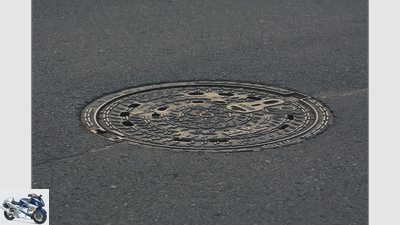
Streblow
5/12
Cast iron manhole covers are slippery. You should therefore avoid them, especially if they are in a curve. Alternatively, raise the motorcycle up slightly and let it roll. The mostly short slides can be balanced more easily.
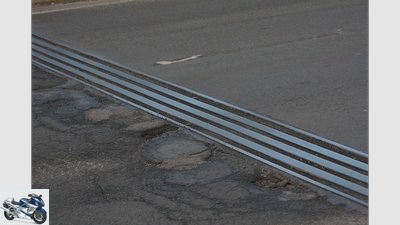
Streblow
6/12
Bridge heels are often garnished with steel plates that hardly offer the tire any grip. Since you cannot drive around it, the general rule here when it rains is: do not brake, do not accelerate, but let the motorcycle roll without tilting if possible.

Streblow
7/12
Blocked areas are not allowed to be driven on, so a lot of dirt accumulates there. For a motorcyclist, however, this means that if he needs it as an alternative space, banking and braking are extremely delicate there.
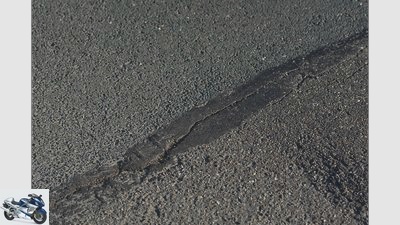
Streblow
8/12
Bitumen strips offer little grip even when dry, but are really smooth when wet. Usually the steering twitches only briefly when one or both wheels roll over it. The wider and bigger they are, the sooner you have to go around them.

jkuenstle.de
9/12
Bad vision and lack of grip – fun is different.
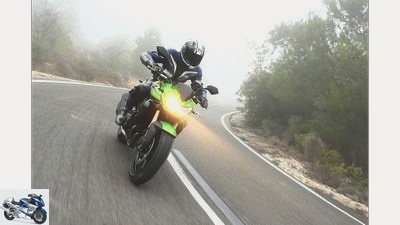
Kawasaki
10/12
Fog and dark visor are a bad combination.

jkuenstle.de
11/12
Even better – yes, gravel roads can also be fun.
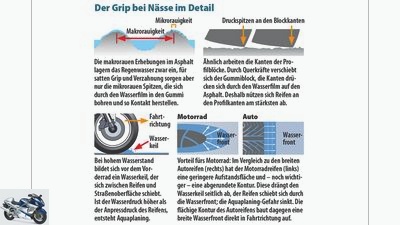
MOTORCYCLE
12/12
Wet roads: danger of slipping.
counselor
Driving experience & Driving tips
Motorcycling under special conditions
Driving in the wet and in the dark
Special conditions
Motorcycles ride well and safely
Rain is nasty, but dry roads don’t protect against slippery spots either. But darkness also presents motorcyclists with special conditions and frustration can also lead to dangerous situations.
Werner &# 34; mini&# 34; Cook,
Nicolas Streblow,
Nicolas Streblow
04/02/2019
Having a beautiful, winding road with the finest asphalt in dry weather to yourself – that’s probably what most motorcyclists dream of. Unfortunately, the reality is often different in our part of the world. And you can neither choose the weather nor the degree of filling of the streets, if you want to move a little further away from the garage at home.
Rain like in the picture above is nasty, but not a big problem with good tires and clothing. Dry and, thanks to the anti-fog visor, also with good visibility, we should still slow down, because the wetness and lower temperatures mean that we have noticeably less grip available. Road markings and bitumen strips, cobblestones and manhole covers are even more slippery than when it is dry. In addition, when we are wet, we cannot perceive such nasty traps as we may later even not notice an oil trail and the like. In dry phases, a lot of oil, dust and rubber abrasion is deposited in the pores of the covering. The next time it rains, these substances are moistened and act like soft soap. Shortly after the onset of rain it is therefore slipperiest, and after a day of continuous rain the grip has often improved again. The drawings on the right explain how the tires can interlock on the wet track.
Bends in the wet: drive soft lines
Bends that can be taken with easy turns in the dry require sensitive use of the accelerator and brakes in the wet. When it rains, the optimal line selection is even more important in curves than on a dry road. A defensive driving style and a smooth, rounded driving style are popular, which is good training for fine motor skills and concentration at the same time. The driving dynamics work no differently in the rain than on a dry road – with the crucial difference that processes such as accelerating, braking, turning and cornering should be much more gentle. If you turn sharply, jump into the iron or turn the gas hastily, you can suddenly overwhelm the tire grip on wet roads. Even when downshifting and engaging the clutch (tip: double-declutching!) You should go to work more gently; It is better to select a higher gear when cornering in order to accelerate smoothly and evenly from a lean angle with less speed.

Curves are pretty tricky when wet. Stop braking before the bend and turn in gently. Set the imaginary apex late so that there is enough space to accelerate gently. It is dangerous to live on the wrong line (dashed), especially since the asphalt there is often polished smooth by car tires and offers less grip.
In all of this, the following applies: stay relaxed. Especially when changing from dry to wet road surfaces, many people tend to tense up. And if you tense up, you will feel the motorcycle’s reactions later, maybe too late. In order to arrive safely in the rain, you should always consciously relax: drop your shoulders, loosen your upper lip, loosen your hands a little, take the tension off your buttocks. This is also possible while driving. In addition, maybe take a break and choose the pace so that you still feel comfortable in spite of the wetness. We recommend training under professional guidance, during which braking maneuvers and cornering on artificially watered road surfaces are practiced intensively.
So that the front wheel does not immediately slip away on the damp asphalt when braking without ABS, it is more careful to pull the brake lever and build up the brake pressure quickly, but a little more slowly than in dry conditions. Stay a little below the personal, trained maximum value. Important: brake hard at the rear. Braking decelerations of up to 8.0 m / sec² can be achieved on non-slip asphalt in the wet. This corresponds to a braking distance from 100 km / h of 48 meters, i.e. only around eight meters longer than the optimum in the dry. However, the risk of a blocking front wheel is relatively high, which requires lightning-fast loosening and gripping. Or an effective ABS, with which you can still get in fully in the rain or on a slippery road surface (see chapter “Correct braking”).
Wet roads: danger of slipping
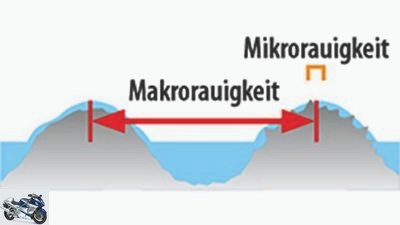
Illustraition: Muller
The macrorough elevations in the asphalt store the rainwater, but only the microrough tips, which drill through the water film and thus establish contact, ensure a good grip and toothing.
In wet conditions, the grip of the tires drops dramatically, which means that significantly less lean angle is possible than on a dry road. However, it depends very much on the road surface. In a coarse surface with fine tips (technical term: microrough), the tire can interlock perfectly and even in wet conditions allows proper inclines, as can be marveled at over and over again in rainy races.
On the other hand, coarse surfaces with smooth edges (technical term: macrorough) such as cobblestones displace the film of water, but the interlocking and thus the tire grip are poor, and the possible inclination is greatly reduced.
Tire grip in the rain

Illustration: Muller
The edges of the profile blocks work in a similar way. The rubber block is displaced by lateral forces and the edges are pressed onto the asphalt by the film of water. This is why tires wear out the most on the edges of the tread.
The tire tread is also extremely important when it is wet, as the water is transported to the outside via the tread grooves and a high pressure builds up on the edge of the tread block. This is the only way to break through the film of water and establish contact with the road.
Silica plays a major role in this context and is now added to many tires. In addition to other good properties, it ensures the necessary elasticity, even at low temperatures, in order to interlock with the micro-rough asphalt peaks.
Aquaplaning on a motorcycle
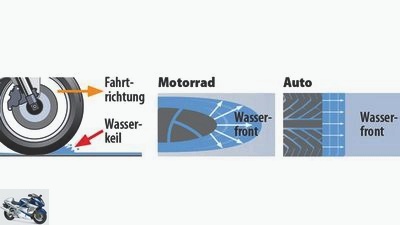
Illustration: Muller
When the water level is high, a water wedge forms in front of the front wheel, which is pushed between the tire and the road surface. If the water pressure is higher than the contact pressure of the tire, aquaplaning occurs.
Advantage for the motorcycle: Compared to the wide car tires (right), the motorcycle tire (left) has a smaller contact area and – more importantly – a rounded contour. This pushes the water wedge to the side, the tire pushes through the water front, and the risk of aquaplaning is reduced. The flat contour of the car tire, on the other hand, creates a wide water front directly in the direction of travel.
Riding a motorcycle in the dark
But even in dry conditions, not all tar is easy to grip, slippery road surfaces are not uncommon. Bitumen strips, for example, which become as smooth as ice in the summer heat, can turn out to be unpleasant surprises. And with gravel or gravel, you also have to cut the gas. Braking maneuvers on slippery terrain work best with ABS.

Streblow
At night, visibility is difficult anyway, due to oncoming traffic, lamps, traffic lights and dark corners in between. With a scratched visor (right) and poor light, the night drive becomes a strenuous lottery
The edges of bends, where cars that cut corners never drive along, also offer more dirt than grip, which makes the choice of line, especially in left bends, demanding.
Excursions in late autumn should also be enjoyed with caution. Residual moisture and damp foliage in shady curves are sometimes as smooth as a mirror, and in river valleys bad banks of fog obstruct the view. The only thing that helps is to sit wide awake, but physically relaxed in the saddle and be on your guard. Especially in adverse circumstances, it is important to make sure that your eyes do not fall in front of the front wheel.
A strategy that is also recommended in the dark. The biggest problem when driving overland: the glare from oncoming drivers. Only good visual guidance helps against this blind flight, i.e. stubbornly stubbornly stare far ahead into the dark on your own lane, consciously away from the headlights of oncoming traffic. It is important to have a clean visor that is as scratch-free as possible, which, in contrast to city traffic, is not so easy to open on the country road.
Frustration can be a source of danger
And when the conditions are perfect, we often have to share the road with others. Does that sound any familiar to you? Even the motorway on the approach was packed, then Sunday column traffic on the favorite route, curve after curve passes without any real driving pleasure.

Artist
Beware, frustration makes you aggressive: If you finally get a free run after a long period of gamble, you should take a deep breath before you accelerate
We just can’t get past, and at some point it’s enough for us – according to the motto “now or never”, we plan to overtake.
This scenario is what accidents are made of in the best of circumstances. As difficult as it is, here we have to wait, wait for the right opportunity. Or take a break, choose a different route, drive the curves on the outer line as far as possible, or try to drive when not everyone else is doing it.
Above all, however, it is important to recognize when you get into such an inner state and then to consciously slow yourself down. Otherwise it can happen that on a dry road, with the best visibility and the finest grip, we simply dig into the next bend far too quickly, brake the car that we have just overtaken and still fly out because we are so frightened that we cannot release the brakes.
Construction site exits
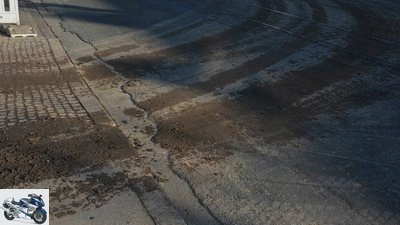
Streblow
construction site exit
These traces of a construction site exit easily throw the motorcycle out of step. In addition, construction workers or construction vehicles can suddenly appear and suddenly force you to brake, which is no fun on such a surface
Restricted areas
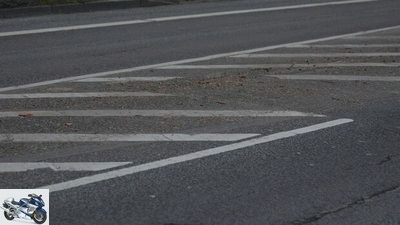
Streblow
Restricted area
Blocked areas are not allowed to be driven on, so a lot of dirt accumulates there. For a motorcyclist, however, this means that if he needs it as an alternative space, banking and braking are extremely delicate there
Bridge heels
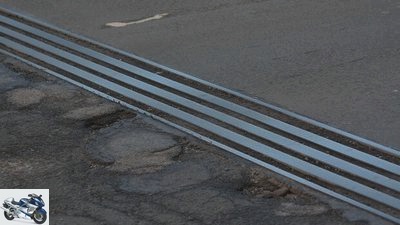
Streblow
Bridge heel
Bridge heels are often garnished with steel plates that hardly offer the tire any grip. Since you cannot drive around it, the general rule here when it rains is: do not brake, do not accelerate, but let the motorcycle roll without tilting if possible
Manhole cover

Streblow
Cast iron manhole cover
Cast iron manhole covers are slippery. You should therefore avoid them, especially if they are in a curve. Alternatively, raise the motorcycle slightly and let it roll. The mostly short slides can be balanced more easily.
bitumen
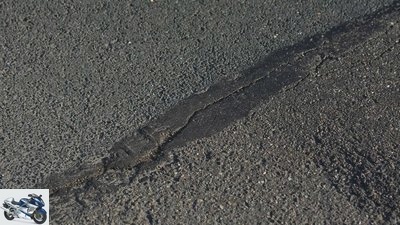
Streblow
Bitumen strips
Bitumen strips offer little grip even when dry, but are really smooth when wet. Usually the steering twitches only briefly when one or both wheels roll over it. But the wider and bigger they are, the sooner you have to go around them
Road markings
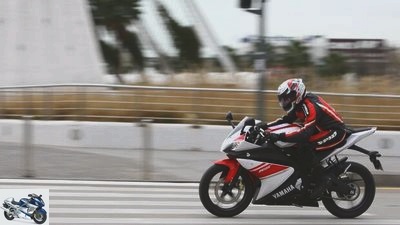
2snap
Zebra crossing
In the dry, zebra crossings and other road markings are no problem, but in the rain, the applied plastic is as smooth as a mirror. Therefore do not accelerate or brake, but simply let the motorcycle roll over them
Related articles
-
Driving tips and advice on motorcycling
fact 26th pictures MOTORCYCLE 1/26 On the way on alpine passes? That’s how it works! MOTORCYCLE 2/26 Seductive winding curves with risk. The course of…
-
motorcycles ABS special ABS special The state of affairs Today only a few incorrigible people are still discussing the point of ABS in motorcycles. The…
-
archive to travel Motorcycling with a load Motorcycling with a load Transporting luggage on the motorcycle Those who go on vacation by motorcycle cannot…
-
Chassis special: Part 10 – Tire wear
archive accesories landing gear & Spring elements Chassis special: Part 10 – Tire wear Chassis special: tire wear Inferring weaknesses in the chassis…
-
3 cylinder special – three cylinders from the 70s and 80s
fact 17th pictures archive 1/17 Kawasaki 750 H2. archive 2/17 Most drivers who wanted to take on the 750-H2 looked into the tube, or rather into these…
-
Jahn Sports & scene Rain and wet Less grip, more caution Driving in rain and wet Riding a motorcycle in the rain cannot always be avoided in this…
-
Gargolov motorcycles Handling special Handling special Comedy in four acts Schnipp – the magic word handling, and all bikers shine. Research the…
-
Breakable accesories Camping special Camping special Motorcycling and camping Thorsten Dentges 06/20/2009 Storm and rain ?? natural enemies of…
-
Buy used – rare motorcycles and special models
Breakable 24 pictures Breakable 1/24 Alejandro Garcia, Neuss, Yamaha R6 Rossi Edition, EZ 6/2005, 14,100 km, 5,290 euros: the classy 600 is very well…
-
archive to travel Photo special for travel Photo special for travel Take better photos The road to a good travel photo doesn’t have to be rocky. If you…